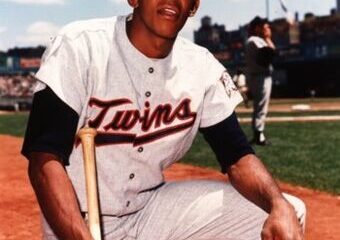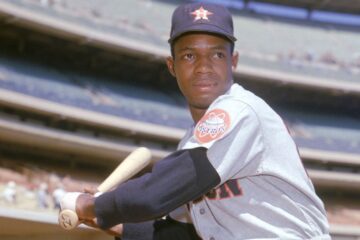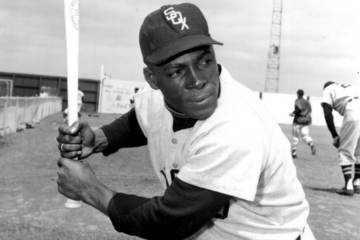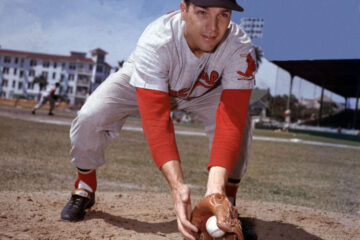The Hall of Fame Index: The top five right fielders of all-time
There is no drama as to who is in the top spot for right fielders. In fact, there is little drama as to who is in the top spot for overall players. Bill James once said that any statistical system that didn’t have Ruth as the top player of all-time was inherently invalid. I’m not sure that is the way to approach analysis, but we will succumb for the time being. I will post two tables before we look at all of the right fielders. The first an abbreviated version of the index with just career and peak value for top players at each position. The second will be the offensive black ink test.
| Career | Peak | Index | |
| Babe Ruth | 514.5 | 296.7 | 811.2 |
| Barry Bonds | 468.0 | 257.9 | 725.9 |
| Willie Mays | 434.5 | 264.0 | 698.5 |
| Ty Cobb | 444.7 | 247.2 | 691.9 |
| Honus Wagner | 399.9 | 257.4 | 657.0 |
| Rogers Hornsby | 357.8 | 263.0 | 620.8 |
| Ted Williams | 363.3 | 246.1 | 609.4 |
| AVG | OBP | SLG | HR | Runs | RBI | SB | Total | |
| Ruth | 1 | 10 | 12 | 12 | 8 | 5 | 0 | 48 |
| Cobb | 12 | 7 | 8 | 1 | 5 | 4 | 6 | 43 |
| Williams | 6 | 12 | 9 | 3 | 6 | 4 | 0 | 40 |
| Hornsby | 7 | 9 | 9 | 1 | 5 | 4 | 0 | 35 |
| Wagner | 8 | 4 | 6 | 0 | 2 | 4 | 5 | 29 |
| Bonds | 2 | 10 | 7 | 2 | 1 | 1 | 0 | 23 |
| Mays | 1 | 2 | 5 | 4 | 2 | 0 | 3 | 17 |
So, obviously there are different results here, but the top is the same. Ruth is the most valuable player of all-time. You could also call him the most dominant player of all-time. Greatest is a term we won’t use because there are esoteric considerations involved. All of those guys will get votes from some and that’s fine. We always have to precisely define our terms. While there is no drama for the top spot, spots two through five might be more interesting.
Career Value
| BWAR | FWAR | WS/5 | Total | |
| Babe Ruth | 182.5 | 180.8 | 151.2 | 514.5 |
| Hank Aaron | 143.1 | 136.3 | 128.6 | 408.0 |
| Mel Ott | 110.7 | 110.5 | 105.6 | 326.8 |
| Frank Robinson | 107.2 | 104.0 | 103.8 | 315.0 |
| Roberto Clemente | 94.8 | 80.6 | 75.4 | 250.8 |
If we ignore Ruth we move immediately to Aaron. Aaron was extremely durable for over 20 years. He highlights the difference between value and dominance. They are similar, but not exactly the same. Was he an inherently more dominant player than Ott or Robinson? If stated another way, was he better at his best than they were at their best? Furthermore, the battle for the third spot might be the most entertaining of the top five.
We could also debate whether Clemente belongs in the top five. The index puts him there, but the offensive numbers won’t compare to other players in the top ten. That being said, the peak value numbers will tell us something different. Then, there are the fielding numbers and we know that is where Clemente shines.
Peak Value
| BWAR | FWAR | WS/5 | Total | Index | |
| Ruth | 102.3 | 109.8 | 84.6 | 296.7 | 811.2 |
| Aaron | 81.6 | 76.3 | 67.6 | 225.5 | 633.5 |
| Ott | 65.4 | 72.5 | 64.2 | 202.1 | 528.9 |
| Robinson | 64.7 | 62.7 | 62.0 | 189.4 | 504.4 |
| Clemente | 68.3 | 57.5 | 53.0 | 178.8 | 429.6 |
So, Aaron really does have some separation between him and the others. The difference likely is one built on methodology. The index uses the top ten consecutive seasons as its base for peak value. Aaron was an incredibly consistent performer. If we had chosen the top ten seasons without worrying about consecutive seasons we likely would find the results were a whole lot closer.
This is more than a passing point because other systems (namely JAWS) do operate that way. JAWS take the top seven seasons. That obviously creates a bit of a different dynamic that might not be enough to take Aaron from the top spot, but might create more issues at the third, fourth, and fifth slots. The index was designed to create more separation. It’s a good jumping off point but going to career and peak value offensive numbers will tell us considerably more.
Offensive Numbers
| OPS+ | Rbaser | OW% | wOBA | |
| Ruth | 206 | -8 | .858 | .513 |
| Aaron | 155 | 44 | .733 | .403 |
| Ott | 155 | 9 | .747 | .430 |
| Robinson | 154 | 34 | .743 | .404 |
| Clemente | 130 | 32 | .655 | .365 |
Ruth’s numbers are stupid. There really is no way in getting around the obvious. The drama comes in the next three guys. How do you really tell the difference between them? This is one of the reasons why we also include peak value offensive performance. This will definitely be the case for someone like Clemente. He took a little longer to develop and finished near the top of his game. Taking his best ten seasons will make a bigger difference.
The other three will likely still finish neck and neck for the second spot. It is the main reason why some would choose someone over Aaron for the second spot. Fielding is important and valuable, but it is not nearly as valuable for a right fielder to be good defensively as it is a for a shortstop or catcher.
| OPS+ | Rbaser | OW% | wOBA | |
| Ruth | 212 | -10 | .856 | .525 |
| Robinson | 165 | 21 | .777 | .415 |
| Aaron | 163 | 44 | .750 | .410 |
| Ott | 160 | 11 | .755 | .441 |
| Clemente | 148 | 22 | .720 | .381 |
Again, it’s close, but it appears that Robinson was slightly better offensively during his prime than Aaron was in his. The difference is not really enough to give him the overall edge without looking at fielding, but it is enough to keep the conversation going. Ott obviously played in a better era for hitters and it was a monochrome game, but based on pure numbers he would have to be included in the conversation.
The bigger jump was Clemente’s. When you consider the defensive value he brought to the equation it is fair to place a vote for him when he was at his best. Of course, the difficulty there is that offense is more valuable than fielding for right fielders in general. So, the qualitative difference between them offensively is quantitatively larger than the qualitative difference defensively.
Fielding Numbers
| Rfield | DWAR | TZOF | DWS/5 | |
| Clemente | 205 | 12.2 | 204 | 11.9 |
| Aaron | 98 | -4.6 | 105 | 13.5 |
| Ruth | 79 | -2.3 | 80 | 8.9 |
| Ott | 50 | -6.0 | 45 | 10.3 |
| Robinson | 22 | -14.8 | 26 | 10.2 |
Occasionally, reputation and evidence reach the same conclusion at the same time. Everyone is under the impression that Clemente was the best right fielder of all-time defensively and the evidence seems to suggest that as well. The large problem with analysis from scouting reports as that they often speak glowingly about skills that are not inherently valuable in terms of producing or preventing runs. Clemente had a cannon for an arm, but how often does that impact a game? Does it impact it as often as a fielder’s range? Luckily for Clemente, he had both in spades.
All of these players were above average to good with the glove. That’s unusual as we have seen when we have lookedat other positions. It certainly doesn’t match reputation. Everyone remembers the grainy videos of a fat Ruth rounding the bases. You’d assume someone like that would be subpar in the field. Reality and perception often don’t intersect.
| Rfield | DWAR | TZOF | DWS/5 | |
| Clemente | 102 | 5.7 | 100 | 7.1 |
| Aaron | 73 | 1.2 | 74 | 6.9 |
| Ruth | 67 | 0.3 | 73 | 6.6 |
| Ott | 33 | -2.4 | 50 | 6.0 |
| Robinson | 0 | -8.6 | 1 | 6.5 |
Again, methodology is key. In the case of the peak offense and peak fielding, we took the numbers from the player’s overall peak. In other words, Ruth was more valuable between 1920 and 1929 than any other ten-year stretch. 1919 comes very close, so some could go 1919 to 1928. So, both the hitting and fielding peak numbers come from that period. For the most part, this ends up being a wash, but for guys like Clemente it makes a considerable difference. He may have had a better ten-year fielding stretch in terms of pure fielding value. Still, he was a better overall player during his ten-year peak value stretch.
You can also see how valuable each player was outside of his top ten seasons. Clemente was obviously a brilliant defender throughout his career whereas guys like Aaron, Ruth, and Ott were more or less average outside of their peak. Like Clemente, Robinson was actually better outside of his peak defensively. It’s enough to where we need to disclose it for intellectual honesty sake.
Playoff Numbers
| PA | SLASH | HR | Runs | RBI | |
| Ruth | 167 | .326/.470/.744 | 15 | 37 | 33 |
| Robinson | 149 | .238/.356/.532 | 10 | 25 | 19 |
| Clemente | 113 | .318/.354/.449 | 3 | 8 | 14 |
| Aaron | 74 | .362/.405/.710 | 6 | 11 | 16 |
| Ott | 69 | .295/.377/.525 | 4 | 8 | 10 |
The third rail in politics is social security. The third rail in sports is playoff performance. Playoff performance brings with it two significant challenges when it comes to dispassionate analysis. First, so much of what we believe is tied up in how the teams did. Ruth’s Yankees won more titles than Robinson’s Orioles, Aaron’s Braves, or Clemente’s Pirates. So, we would be led to believe that he was better.
The truth is that the Yankees were better and the Orioles in 1969 and 1971 were disappointments. Ironically, Clemente’s Pirates beat Robinson’s Orioles in that last World Series. So, is Clemente the better player because his teams were more successful? This brings us to the second problem with analysis. Even if we go strictly by the numbers, how valuable are those numbers when we are talking about 100 or so plate appearances? We are talking about roughly a month’s worth of action.
BWAR MVP Points
| Top 10 | Top 5 | MVP | Points | |
| Ruth | 2 | 3 | 11 | 131 |
| Ott | 3 | 10 | 3 | 89 |
| Aaron | 2 | 13 | 1 | 81 |
| Robinson | 3 | 6 | 1 | 49 |
| Clemente | 5 | 4 | 1 | 45 |
We see unanswerable questions throughout baseball history. What numbers would have Ted Williams, Joe DiMaggio and others put up if it weren’t for missing time in World War II and Korea? What would have happened for guys like Jackie Robinson and Roy Campanella without the color barrier? Here we see another question. What would have Ruth done had he spent his entire career as a position player?
He became a full-time pitcher in 1915 and didn’t become a full-time position player until 1919. He finished in the top ten in pitcher WAR twice in those first four seasons. If we tack on those six points, we jump up to 137 total BWAR MVP points. Had he not pitched at all he might have finished in the top five or even earned an additional BWAR MVP. We will never know. He might have also tacked on close to 40 additional home runs and maybe 200 or so runs and RBI. Those estimates are fairly conservative. He might have eclipsed 2500 runs and RBI. The sum seems utterly ludicrous.
As for the other spots, there are points in Ott’s, Aaron’s, and Robinson’s favor for the second slot. I tend to go with the conventional choice, but I wouldn’t sneeze at any other choice among those three. I can even be talked into including Clemente in that group if we are talking purely about diversity of skills and not on mathematical value.





